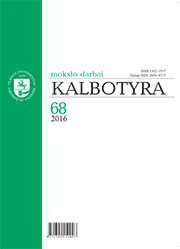Imperatyvinės kilmės diskurso markeriai lietuvių kalboje: klausyk ir žiūrėk atvejis
Imperatives as Discourse Markers in Lithuanian: The Case of Klausyk ‘Listen’ And Žiūrėk ‘Look’
Author(s): Erika Jasionytė-MikučionienėSubject(s): Syntax, Lexis, Semantics, Pragmatics, Baltic Languages
Published by: Vilniaus Universiteto Leidykla
Keywords: perception verbs; imperative; discourse marker; grammatical meaning; pragmatic meaning; multifunctionality;
Summary/Abstract: The present paper deals with the imperatives of intentional visual as well as auditory perception as pragmatic markers in Lithuanian. The pragmatic functions of the imperative forms of the Lithuanian perception verbs have not been examined yet. Thus, the aim of the paper is to explore the frequency of the imperatives klausyk ‘listen’ and žiūrėk ‘look’ and the way in which they are used. The data have been collected from the Corpus of the Contemporary Lithuanian Language, namely its subcorpus of fiction texts. The study shows that the Lithuanian imperatives of intentional visual as well as auditory perception are multifunctional and exhibit a variety of functions: the directive to listen or to look, the attention-getting device, the argumentation marker, the directive to consider, the interruptive directive and others. The uses that the imperatives under study share are: the directive to listen or to look, the attention-getting device, the directive to change the topic and the argumentation marker. Besides the functions mentioned above, the imperative of intentional visual perception is used to express the speaker’s contradiction to what is said. The imperative of intentional auditory perception, by contrast, cannot fulfil this function. In the subcorpus of fiction texts, the number of the occurrences of the imperative žiūrėk ‘look’ is larger than the number of the occurrences of the imperative klausyk ‘listen’. The relatively higher frequency of žiūrėk ‘look’ correlates with a wider range of uses. As a pragmatic marker, the Lithuanian žiūrėk ‘look’ is most typical as the expressive directive that conveys the speaker’s stance toward visually accessible information or the interlocutor’s speech. Žiūrėk ‘look’ as an attention-getter or an argumentation marker is not as typical as its correspondences in other languages. However, in contrast to its auditory counterpart, the imperative of intentional visual perception retains more of its lexical meaning and its imperative use can be based on such lexical readings as ‘to think, imagine’, ‘to take care of somebody’ or others. Klausyk ‘listen’ in its turn is more typically pragmatic. It most often serves as an attention-getting device by which the speaker seeks to obtain the addressee’s attention. As an attention-getter, klausyk ‘listen’ usually appears in a clause-initial position and it is usually followed by questions.
Journal: Kalbotyra
- Issue Year: 2016
- Issue No: 68
- Page Range: 23-41
- Page Count: 19
- Language: Lithuanian

